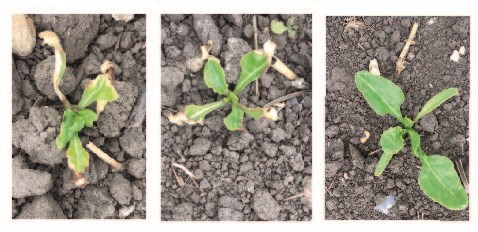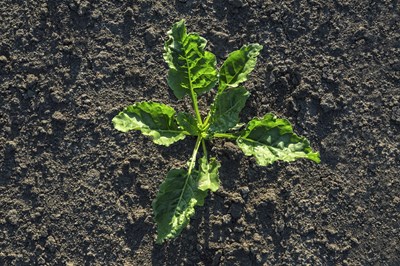The larger the canopy at this point the more light will be intercepted and converted into yield. It is also important as it pushes the plant to reach the 12th leaf stage when we know mature plant resistance begins to reduce the transmission of virus in crops.
Hitting crops hard with post-emergence herbicides can delay canopy development substantially. Worst case scenarios include severe phytotoxic effects such as leaf necrosis or even the death of plants, in less severe cases plants just look shocked and become pale (to varying degrees) and are slow to grow and produce further leaves.

Herbicide damage symptoms ranging from severe on the left to unaffected on the right.
Depending on the severity, it is estimated that herbicide damage (especially from the first- T1 application) to plants can result in 5-15% loss of yield. Add to this the fact that weakened plants are then more susceptible to subsequent infection by pests and diseases, such as nematodes, flea beetle, Aphanomyces and Rhizoctonia, the yield loss can become greater, certainly exceeding 20%.
So, what do we need to do to reduce the risk of herbicide damage? Here is a check list of some of the things you need to consider:
Different varieties – by making sure you know where different varieties are, you will be able to check the minimum growth for applying different products – per variety. The difference between cotyledon fully expanded and first true leaf fully expanded important. For example, the recommendation for Betanal MaxxPro + Goltix is expanded cotyledons and for Betanal maxxPro + Debut + oil is the first pair true leaves fully expanded. Our experience tells us that different varieties can vary considerably in the early stages of development. The consequence can be serious. The photograph below show some missing drills of plant. These were a different variety which was slightly slower in development and was therefore hit hard by the first herbicide. Of course, development stages of the same variety may vary across the field too, due to soil type and seedbed conditions, so it is important to check fields carefully for growth stages.
 is
is
Select products carefully- It is important to consider tailoring your choice of product, rate and the inclusion of adjuvant or nutrients to crops. Don’t apply a ‘blueprint’ approach without checking each crop, especially those on different soil types or in different locations. Remember that stressed crops will always be more susceptible to damage.
Be particularly careful with the use of adjuvants such as oil. Firstly, it is important to check there is approval for use on beet but also check temperature, crop growth stage and rate of use information. The inclusion of nutrients such as manganese and nitrogen can also ‘hot-up’ a mix, especially when used with the first post-em herbicide application. Again, any crops under stress will be more susceptible to this.
Weather conditions – product labels carry extensive information about the effect weather can have on crop tolerance and the reality is that if you follow all of these, you may never find a window to apply the herbicide at the right crop and weed growth stage! So, it is a case of weighing up the risks. Experience tell us that high temperatures, particularly when the night temperature is still quite low and there is a large temperature range experienced by plants across 24 hours, increases the sensitivity of the plant canopy. High light intensity, especially high UV levels are important factors and usually occur ‘hand in hand’ with high temperatures.
Picking you moment to spray crops is key, as is adjusting rates or mixes where there is a risk. Unfortunately, where you have a large area to spray, clearly there are only so many early mornings and evenings available! The other weather factor not to forget is spraying around frosty weather so, it is really is a case of ‘weighing up the odds’ and monitoring crop and conditions carefully.




